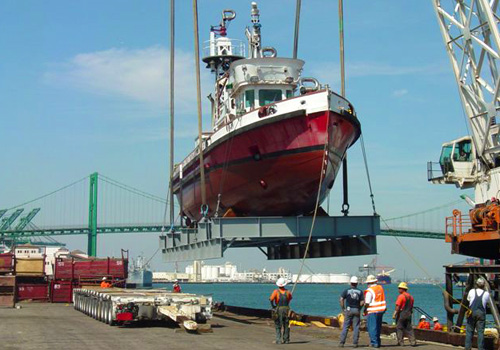Sunday, May 31, 2009
L.A. THEN AND NOW
Heroic Fireboat 2 is out of the water

THE LITTLE CRAFT THAT COULD: The Los Angeles Fire Department's Boat 2 is lowered into dry dock in
San Pedro in 2004. The vessel was officially named the Ralph J. Scott in 1965, in honor of a former chief.
The intrepid vessel served the L.A. Fire Department for 78 years and is a National Historic Landmark. But it's on blocks these days, waiting to be housed in a nearby San Pedro museum.
By Steve Harvey
May 31, 2009
After all the harrowing situations it had faced -- the ship fires, the explosions, the waterfront blazes -- Fireboat 2 nearly met its end in quieter fashion a few years ago.
The L.A. Fire Department vessel was docked at Terminal Island when an onboard visitor, the craft's retired pilot Bill Dahlquist, noticed a hole beneath the waterline of its eroded hull. Boat 2 was taking on water, fast.
What did Dahlquist do? He plugged the leak with a paintbrush handle.
It was not a glorious moment for a vessel that had served longer than any other boat in the Fire Department, from 1925 to 2003, and is registered as a National Historic Landmark. But at least Dahlquist, the quick-thinking one-man crew, had saved Boat 2.
The question is what to do with it now.
Removed from Terminal Island, the cigar-shaped, red-and-white craft is a fireboat out of water these days, sitting quietly on blocks next to Fire Station 112 in San Pedro.
The department's Historical Society and the Port of Los Angeles are trying to raise funds for a nearby museum that would house the 99-foot-long boat and celebrate its contributions and those of its crew members. The vessel was officially named the Ralph J. Scott in 1965 in honor of a former chief. But most crew members continued to call it Boat 2.
"It needs to be under cover," said Dahlquist, 79, a former director of the historical society. Its exposure to the elements "upsets me," he added.
When launched in 1925, Boat 2 was one of the most powerful of its kind, capable of spraying more than 12,000 gallons of water per minute. In other words, Boat 2 could fill your swimming pool in a minute.
It joined the Fire Department when the dangers in the growing harbor area were becoming apparent.
"It was a time when every house in Southern California began as a stick of lumber that came through that port," Dahlquist said. "And the ships were wooden and the wharves were wooden."
Not long after its debut, Boat 2 helped put out a fire aboard the schooner Sierra, which was carrying, sure enough, Douglas fir lumber.
Boat 2 later "fought fires in baled cotton on the docks, fires in refineries and aboard ships and in warehouses," wrote Dahlquist and Frank Borden, a retired assistant chief and current director of the historical society.
Perhaps Boat 2's most famous challenge occurred in 1947 after the tank ship Markay exploded in Wilmington while loading a gasoline-and-butane blend, killing 22 people. The debris scattered for miles.
One San Pedro housewife called police to report that "a Russian bomber had crashed into her backyard," historian Paul Ditzel wrote in Westways magazine. Officers instead "found a hot chunk of twisted iron from the Markay's deck."
Boat 2 plunged into the smoke and was able to douse the warehouse and wharf fires before they spread.
"Smoke was so thick I couldn't see the compass," recalled pilot Brainard "Choppy" Gray. "I knew if we got lost, we could have crashed into the wharf or Markay."
Some referred to the incident, with a bit of exaggeration, as "the night Boat 2 saved Wilmington," Ditzel wrote.
Another famous harbor disaster was the 1976 explosion of the supertanker Sansinena, which killed nine people and injured 22.
Boat 2, then a youthful 51 years old, and its counterparts rescued 18 crew members.
But through the years, there were light moments as well.
In 1935, The Times ran an article headlined "Sea Serpent Seen at Harbor Here, Crew Reports." It told of the sighting of a three-headed monster by the men aboard Boat 2, adding that they sounded sober. It may be worth noting that the sighting occurred on March 31, the day before April Fools' Day.
Boat 2 had ceremonial duties as well, shooting streams of water as high as 175 feet to salute ships arriving or leaving the port for the first time.
"We'd get a call sometimes at 4 a.m. and there'd be no one else to watch, but that was the custom so we always did it," Dahlquist said.
The old vessel won't be shooting water into the sky anymore. But Dahlquist hopes that public contributions will one day allow visitors to tour Boat 2, which is in need of rehabilitation.
The hunk of iron is "over 80 years old and it was in saltwater almost all its life," he said. "A lot of things need to be done."
As for his 16-year-tour of duty as its pilot, Dahlquist said, "I would have done it for free. I just never told anyone."
steveharvey9@gmail.com
|